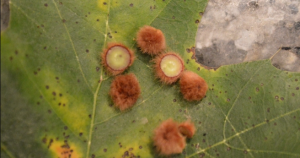
I was walking up to one of the county office buildings when I noticed it on the ground—a dead oak leaf lying bottom-up, with marble-sized, fuzzy brown orbs attached. I picked it up to examine the leaf and its odd attachments more closely, thinking at first it might be a small caterpillar. On further examination, I realized there were several more identical leaves with brown fuzz nearby.
The idea for this blog came from noticing insect galls in the leaves of oak trees. Based on my prior experience with those, I realized that these intriguing structures were also insect galls. Insect galls are hard, three-dimensional growths on the leaves or stems of plants. While galls can form on many species of plants, 60% of the time they are found on oak trees and created by gall wasps that have laid eggs into the plant tissue. Much like human skin reacts to a splinter or insect bite by swelling around it, plant cells respond to this foreign tissue by growing a gall around the expanding egg sac to protect the plant. Insect larvae eventually feed on the gall tissue until they’ve reached adulthood. Many galls have small pinholes, a sign that the adult insect has emerged, and the gall is empty.

This particular gall is known as a “woolly oak gall” and is indeed the creation of a small, harmless Cynipid wasp. The galls are part of the wasp’s life cycle. After developing on the leaf, the gall will darken in color, fall off later in the fall, and once pupated the larvae will bury in the ground until development is completed.
While strange looking, galls rarely cause problems for the plants and are an example of commensalism, a relationship in which one organism benefits while the other is neither harmed nor helped. The word “gall” means “bitter”, a reference to the taste of these tannin-filled growths.
 2
2
